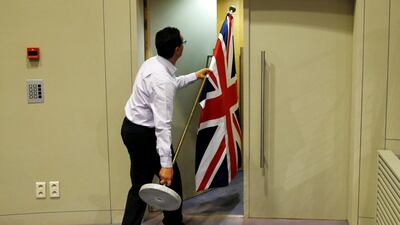Britain sought to push forward talks with the European Union on Tuesday, setting out proposals for a temporary post-Brexit customs agreement with the bloc and two options for how its longer-term trading relationship could work.
Below is a summary of the proposals:
TRANSITION PERIOD
While the government is clear Britain will leave the EU's customs union in March 2019, it has proposed a continued close association for a time-limited period to minimise disruption and allow a smooth and orderly transition to the new arrangements.
This period would involve:
A new customs union with no customs processes or duties between Britain and the EU, and a shared external tariff
Britain being able to pursue new trade agreements with non-EU countries during the interim period, although such deals would not be brought into effect until after the transition
The government put forward two options for its future customs relationship with the EU:
1) "A HIGHLY STREAMLINED CUSTOMS ARRANGEMENT"
This would see the UK and EU trade with each other effectively as third parties but look to make customs procedures as frictionless as possible, including using technology to make it easier for businesses to comply with customs procedures.
Britain acknowledged this system would involve an increased administrative burden compared to being inside the EU's customs union. It also said it had looked at customs agreements between other countries but was not seeking to replicate another country's model.
Britain said such a system would:
Ensure businesses declare goods for import or export and provide the revenue and customs department with documentation including customs declarations, safety and security information
Enable the government to verify a declaration has been made and ensure any duties have been paid
Require new systems to be put in place on both the UK and EU sides, as well as Britain making improvements to its domestic regime
Reduce the risk of delays at ports by using technology such as pre-arrival notification of consignments, linked to customs declarations and vehicle registration numbers, so vehicles do not need to stop at the border
Replicate existing cooperation with the EU on data sharing and customs cooperation to reduce security risks and improve targeting of inspections
_______________
Read more:
UK outlines post-Brexit free and frictionless border plans
Calls for solutions to Brexit transition
_______________
Reduce the time and cost of complying with customs procedures through measures such as self-assessment, allowing traders to calculate their own customs duties and speeding up authorisation through greater automation
Involve looking to agree simplified systems for moving goods across borders including:
a) a continued waiver from the requirement to submit entry and exit declarations for goods moving between UK and EU
b) membership of the Common Transit Convention, meaning goods could travel from the UK through the EU to the rest of the world, and vice versa, without paying EU duties
2) "A NEW CUSTOMS PARTNERSHIP WITH THE EU"
This would see Britain align its approach to customs with the EU in a way that removed the need for a UK-EU customs border. One such option would be for Britain to mirror the EU's requirements for imports from the rest of the world where the final destination is the EU.
The government acknowledged this was an untested approach which would take time to implement.
Britain said that under such a system:
_______________
Read more:
Ryanair chief sees Brexit flights storm brewing
UK customs checks seen costing £1 billion pounds a year post-Brexit, Oxera says
_______________
It would need to apply the same tariffs as the EU and the same treatment on rules of origin for goods arriving in the UK before heading on to the EU
Mirroring the EU's customs approach at its external border would ensure all goods entering the bloc via the UK have paid the correct EU duties
The need to introduce customs procedures between Britain and the EU would be removed, so goods moving between the two would be treated as they are now for customs purposes
-Britain could apply its own tariffs and trade policy to UK exports and imports from other countries
-Britain would require a "robust enforcement mechanism" to ensure goods that do not comply with EU trade policy stay in Britain
NEW LEGISLATION
As rules governing customs mostly come under EU law, the government said Britain would introduce new domestic legislation via a customs bill later this year.
This legislation would seek to ensure British law remains as consistent as possible with EU law, but will also give the government powers to operate standalone customs, tax and excise systems in the event Britain and the EU fail to reach a deal.
NO DEAL SCENARIO
Britain said that while it hoped to reach a negotiated agreement with the EU, it was also looking at ways to mitigate the impact of not reaching a deal. It said that it expected a "no deal" scenario would mean:
Britain would treat trade with the EU as it currently treats trade with non-EU countries and apply customs duties and import tax on EU imports
Britain would require traders to be registered, with those exporting to the EU needing to submit export declarations and some goods may need export licences
The EU would apply the same customs rules and tax to imports from Britain that it applies to non-EU countries

